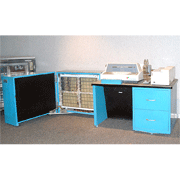NEC developed the NEAC-1210 in 1964 as an ultra-compact computer that could be used for many different business applications. While maintaining the price point of previous small computers, the NEAC-1210 offered high performance and a stored program methodology. The NEAC-1210 deserves special mention as an early computer because it was the first computer that was successfully planned and produced in Japan and over 700 machines were delivered by August 1966, a record for domestic production at the time.
Prior to the NEAC-1210’s development, NEC, focusing on the marketability and future potential of ultra-compact computers, developed the NEAC-1201 computer in 1961. Following on from this success, NEC created the NEAC-1210’s basic system from an arithmetic unit, an operating console (including a memory unit), and the NEAC Writer (a typewriter, tape reader, and tape puncher). The inclusion of the memory unit meant a stored program could be used. The computer’s parametron logic circuit elements made it possible to build reliable, inexpensive, and compact arithmetic units. NEC also developed and used a compact, reliable, and durable magnetic drum (with a memory capacity of 3,000 digits) for the memory unit. Because its small footprint meant the system did not need a special installation facility and could be installed in a regular office, the system was very economical as well. NEC exhibited the NEAC-1210 for six months starting in May 1965 at the New York World’s Fair, and was awarded the 12th Okochi Memorial Prize in April 1966. Lessons learned from the NEAC-1210 helped the development of the NEAC-1240, announced in 1967, and the NEAC System 100 office computer that went on sale in 1973. NEC still has a NEAC-1210 arithmetic unit and operating console set.
| NEAC-1210 | |
| Completion date | September 1964 |
| Control methodology | Stored program method |
| External numerical word format | 8-bit, binary-coded decimals |
| Internal numerical word formats | Positive numbers: 12 digits (long word) or six digits (short word) |
| Negative numbers: 11 digits | |
| Instructions (commands) | One addressing method, 26 commands |
| Calculation method | Binary-coded decimal notation, fixed decimal point method |
| Calculation speeds | Addition and subtraction: 〜40 ms |
| Multiplication: 〜20 ms (on average) per significant ACC digit | |
| Division: 〜120 ms (on average) per significant ACC digit | |
| Arithmetic elements | Parametron logic circuit elements |
| Memory elements | Compact magnetic drum |
| Capacity: 3,000 digits (250 long words or 500 words) | |
| Parity check | |
| I/O devices | Photoelectric reader, 2,400 characters per minute |
| Electromechanical typewriter, 48 keys, 600 characters per minute | |
| Paper tape reader, 560 characters per minute | |
| Paper tape puncher, 1000 characters per minute | |
| External dimensions and weight | Arithmetic unit: 600 x 800 x 750 mm (w x d x h), 195 kg |
| Operating console: 1,080 x 700 x 650 mm (w x d x h), 100 kg | |
| Power supply | 100 VAC ± 10%, 50/60 Hz (specified before delivery) |
| Power consumption | Under 1 kVA |


